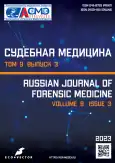Влияние алкогольного опьянения на период выживания при субдуральном кровоизлиянии
- Авторы: Аверкин Н.С.1,2, Столяров А.П.1, Харитонов Е.А.1, Живанкина И.С.2
-
Учреждения:
- Областное бюро судебно-медицинской экспертизы
- Пензенский государственный университет
- Выпуск: Том 9, № 3 (2023)
- Страницы: 269-278
- Раздел: Оригинальные исследования
- URL: https://journals.rcsi.science/2411-8729/article/view/148351
- DOI: https://doi.org/10.17816/fm7130
- ID: 148351
Цитировать
Полный текст
Аннотация
Обоснование. Черепно-мозговая травма ― актуальная проблема в судебно-медицинской экспертизе, субдуральная гематома считается наиболее опасной среди них. В судебной-медицинской практике важно понимать исход субдуральной гематомы в зависимости от её объема, представлять её патогистологическую эволюцию и знать при этом сущность изменений в головном мозге.
Цель исследования ― изучить влияние алкогольного опьянения на период выживания при субдуральном кровоизлиянии.
Материалы и методы. В ретроспективное исследование включены акты (n=42) судебно-медицинских исследований смертельных случаев с субдуральной гематомой, из которых выделены две группы ― лица, скончавшиеся до оказания медицинской помощи (n=20), и лица, получившие медицинскую помощь в условиях стационара (n=22). Установлены обстоятельства полученной травмы, количество излившейся крови под твёрдую мозговую оболочку, наличие и степень алкогольного опьянения; отмечен уровень сознания по шкале комы Глазго. Проведено гистологическое исследование субдуральной гематомы для определения её возраста.
Результаты. Уличные травмы и дорожно-транспортные происшествия ― наиболее частые причины субдуральной гематомы. В 52,3% случаев гематомы сочетаются с переломами черепа, в 73,8% ― с лептоменингеальными кровоизлияниями, в 81% ― с ушибами, в 88% ― с отёком головного мозга. Односторонняя субдуральная гематома встречается чаще, чем двусторонняя. У большей части пострадавших зафиксирован факт алкогольного опьянения, при этом концентрация этилового алкоголя в крови у лиц, скончавшихся до оказания медицинской помощи, была выше в 2 раза. Установлены значимые корреляции между степенью нарушенного сознания по шкале комы Глазго и концентрацией этилового алкоголя в крови (r=-0,701, р <0,05), объёмом субдуральной гематомы (r=-0,526, р <0,05) и периодом госпитализации (r=0,559, р <0,05).
Заключение. Лица с субдуральным кровоизлиянием в состоянии более тяжёлой степени алкогольного опьянения, как правило, погибают до оказания им медицинской помощи, при этом если помощь была оказана, то исход чаще всего неблагоприятный, сопровождается более коротким периодом выживания даже при наличии гематомы малого объёма. Гистологический метод на сегодняшний день ― наиболее оптимальный с точки зрения определения давности субдуральной гематомы.
Ключевые слова
Полный текст
Открыть статью на сайте журналаОб авторах
Никита Сергеевич Аверкин
Областное бюро судебно-медицинской экспертизы; Пензенский государственный университет
Автор, ответственный за переписку.
Email: averkin.n@list.ru
ORCID iD: 0000-0001-8129-9400
SPIN-код: 7973-2100
канд. мед. наук
Россия, Пенза; ПензаАркадий Петрович Столяров
Областное бюро судебно-медицинской экспертизы
Email: sudmed_penza@mail.ru
ORCID iD: 0000-0001-6946-9059
SPIN-код: 3649-4766
канд. мед. наук
Россия, ПензаЕвгений Александрович Харитонов
Областное бюро судебно-медицинской экспертизы
Email: haritonovdoc@mail.ru
ORCID iD: 0009-0004-2680-7432
SPIN-код: 9183-6366
канд. мед. наук
Россия, ПензаИрина Сергеевна Живанкина
Пензенский государственный университет
Email: izhivankina@list.ru
ORCID iD: 0000-0002-8927-2584
Россия, Пенза
Список литературы
- Monsivais D., Choi H.A., Kitagawa R., et al. A retrospective analysis of surgical outcomes for acute subdural hematoma in an elderly cohort // Interdiscip Neurosurg. 2018. N 14. P. 130–134. doi: 10.1016/j.inat.2018.07.010
- Фролова И.А., Фролов В.В. Судебно-медицинская оценка патоморфологии и этиологии субдуральных гематом // Судебная медицина. 2015. T. 1, № 2. С. 51–52.
- Sivandzade F., Alqahtani F., Cucullo L. Traumatic brain injury and blood-brain barrier (BBB): Underlying pathophysiological mechanisms and the influence of cigarette smoking as a premorbid condition // Int J Mol Sci. 2020. Vol. 21, N 8, P. 2721. doi: 10.3390/ijms21082721
- Chmieliauskas S., Anuzyte J.S., Liucvaikyte J., et al. Importance of effusion of blood under the dura mater in forensic medicine: A STROBE--compliant retrospective study // Medicine (Baltimore). 2018. Vol. 97, N 39. P. e12567. doi: 10.1097/MD.0000000000012567
- Liu X., Gao C., Yuan J., et al. Subdural haematomas drain into the extracranial lymphatic system through the meningeal lymphatic vessels // Acta Neuropathol Commun. 2020. Vol. 8, N 1. P. 16. doi: 10.1186/s40478-020-0888-y
- Altaf I., Shams S., Vohra A.H. Role of surgical modality and timing of surgery as clinical outcome predictors following acute subdural hematoma evacuation // Pak J Med Sci. 2020. Vol. 36, N 3. P. 412–415. doi: 10.12669/pjms.36.3.1771
- Anis S.B., Khan S.A., Mitha R., Shamim M.S. Craniotomy or craniectomy for acute subdural hematoma? Difference in patient characteristics and outcomes at a tertiary care hospital // Asian J Neurosurg. 2022. Vol. 17, N 4. P. 563–567. doi: 10.1055/s-0042-1758842
- Aromatario M., Torsello A., D’Errico S., et al. Traumatic epidural and subdural hematoma: Epidemiology, outcome, and dating // Medicina. 2021. Vol. 57, N 2. P. 125. doi: 10.3390/medicina57020125
- Baucher G., Troude L., Pauly V., et al. Predictive factors of poor prognosis after surgical management of traumatic acute subdural hematomas: A single-center series // World Neurosurg. 2019. N 126. P. 944–953. doi: 10.1016/j.wneu.2019.02.194
- Akbik O.S., Starling R.V., Gahramanov S., et al. Mortality and functional outcome in surgically evacuated acute subdural hematoma in elderly patients // World Neurosurg. 2019. N 126. P. 1235–1241. doi: 10.1016/j.wneu.2019.02.234
- Poon M.T., Rea C., Kolias A.G., et al. British neurosurgical trainee research collaborative (BNTRC). Influence of antiplatelet and anticoagulant drug use on outcomes after chronic subdural hematoma drainage // J Neurotrauma. 2021. Vol. 38, N 8, P. 1177–1184. doi: 10.1089/neu.2018.6080
- Недугов Г.В., Федорина Т.А. Новая патоморфологическая классификация субдуральных гематом // Наука и инновации в медицине. 2020. Т. 5. № 2. C. 130–135. doi: 10.35693/2500-1388-2020-5-2-130-135
- Bertozzi G., Maglietta F., Sessa F., et al. Traumatic brain injury. A forensic approach: A literature review // Curr Neuropharmacol. 2020. Vol. 18, N 6. P. 538–550. doi: 10.2174/1570159X17666191101123145
- Rao M.G., Singh D., Vashista R.K., Sharma S.K. Dating of acute and subacute subdural haemorrhage: A histo-pathological study // J Clin Diagn Res. 2016. Vol. 10, N 7. P. HC01-7. doi: 10.7860/JCDR/2016/19783.8141
- Dell’Aquila M., Maiese A., De Matteis A., et al. Traumatic brain injury: Estimate of the age of the injury based on neuroinflammation, endothelial activation markers and adhesion molecules // Histol Histopathol. 2021. Vol. 36, N 8. P. 795–806. doi: 10.14670/HH-18-319
- Li N., Du Q., Bai R., Sun J. Vitality and wound-age estimation in forensic pathology: Review and future prospects // Forensic Sci Res. 2018. Vol. 5, N 1. P. 15–24. doi: 10.1080/20961790.2018.1445441
Дополнительные файлы









